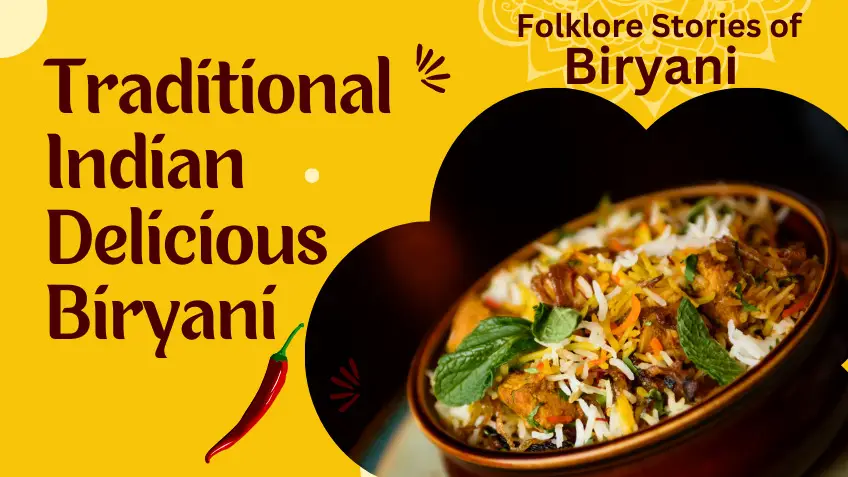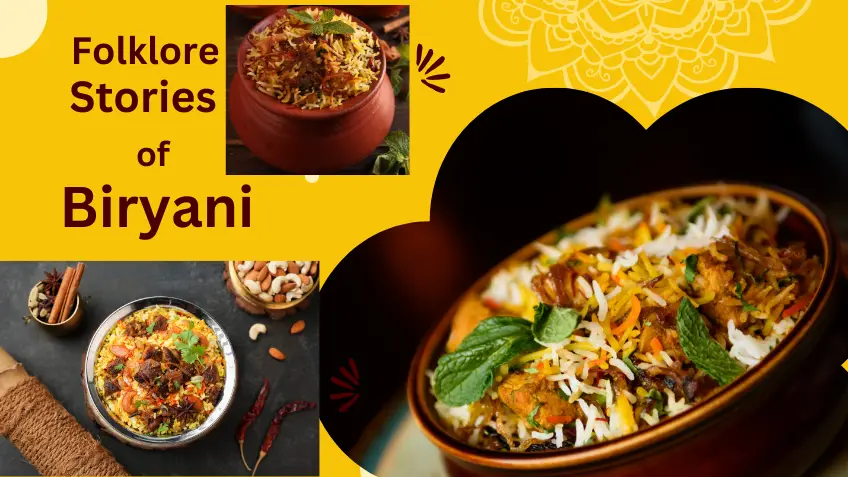Folklore and the Biryani STORIES: Flavours of History

No other Indian food has as many stories to tell as biryani does. The stories of biryani are as varied as the taste and flavours of the dish across the country. When we eat the first morsel of the biriyani, we wonder: Who was the person who first thought of such an amazing thing, and what must have been the idea behind it? Let us try to unravel those Biriyani mysteries.

Biryani is derived from the Farsi or Persian word Biriyan, meaning “fried before cooking”. It is believed to have first originated in Persia and that it might have taken different routes to travel to many parts of the world. The Persian style of cooking (Dum)—slow breathing in the oven—and the name derivation have been the sources to justify this belief.
As far as how it reached India, there are many interesting stories that bear testimony. Some say it could have traveled via Afghanistan to North India, or it could have been bought by the Arab traders via the Arabian Sea to Calicut. Few believe that “Taimor”, a Muslim ruler, bought the dish from Persia to India in 1394. And quite a number believe that the Mughal courts were the ones who enticed the biriyani from Afghanistan and fused their cooking styles with the Persian influence.
From North India, it was brought to Hyderabad by Aurangazeb when he invaded the south. From then on, Biriyani remained the royal dish of the Nawabs and Nizams and became a celebration dish. (In fact, Lucknow’s Awadhi biriyani is claimed to be the first of the lots.)
(Nawab is generally used for the rulers of Awadh and Central Provinces, and Nizam is the title which rulers of Hyderabad take.)

On how it was brought to regions of South India, another legend has it that the southern Malabar coast of India was frequently visited by Arab traders who influenced the cooking styles and made biryani popular.
There are records of a rice dish known as Oon Soru in Tamil literature as early as the year 2 AD. Oon Soru was said to be made of rice, ghee, meat, coriander, pepper, turmeric, and bay leaf and was used to feed military warriors.
FOLKLORE STORIES:
These two folklore stories deserve a special mention as they are very interesting and attractive to read.
Many believe that the dish originated in the 15th century, during Mughal Emperor Shah Jahan’s rule. Once, when Shah Jahan’s queen Mumtaz visited the military barracks, she found that the soldiers were undernourished and asked her royal chef to cook a rice dish that would encompass all quality nutrients, and therein lay the origin of this dish with all the spices and nutrients.

Another story that explains Biryani’s widespread popularity is that of a traveler from Hyderabad who, on his maiden journey to the land of deserts, Dubai, stumbled upon a tribe based in Al Bastakiya district. As he reached there, he gave some spices that he got from Iran to the tribe’s head chef in exchange for a night’s stay in the small district. That night, the tribesmen learned that their small village would be attacked by a group of bandits. Since it was impossible to move all goods and food to a safe place in such a short time,

He took a huge clay pot and created three layers consisting of rice, meat, and some gravy on top. He then poured some water into the mixture and hid the pot beneath the hot sand. After the attack, he removed it and presented a cooked dish to the fellow villagers. The immense heat of the desert sun cooked an entire pot of rice along with some spices and meat. The enticing aroma of the Iranian spices and rice enchanted the villagers. This is how the Biryani cooked in the Arabian Desert grabbed the traveller’s attention. He spread the recipe while coming back to his home town of Hyderabad.
Local folklore attributes the creation of Hyderabadi biryani to the chef of the first Nizam, Nizam-ul-Mulk, Asaf Jah I, in the mid-18th century, during a hunting expedition.
What is the story behind biryani?
It is said that Mumtaz once visited the army barracks and found the Mughal soldiers looking weak and undernourished. She asked the chef to prepare a special dish that combined meat and rice to provide balanced nutrition to the soldiers, and the result was biryani, of course.
What is the cultural significance of biryani?
Biryani is more than just a dish; it is a cultural phenomenon that unites people across India and beyond. From its historical origins to the regional variations that showcase the diversity of Indian cuisine, biryani weaves stories of tradition, celebration, and culinary artistry.
The Turkish Origins or the Indian Variations: What Is the Story of the Aromatic Pilaf?
Through a series of notions, it can be deduced that there are largely two believable schools of thought on the origins of pilaf. A rice dish that has been a pioneer in introducing us to biryanis and pulao’s seems to be lost in its origins today. Find out why.

There are largely three kinds of Indian cultures that go big on rice, as far as my knowledge is concerned. One are the Bengalis, who love their fish and prawn curries with a side of steamed rice; then there are the South Indians, who also love rice as much as the parottas; and finally, the Bihari’s, to whom I’ve been a fair witness. Having been close to a Bihari friend for the past nine years, something that I have established about their eating habits is that they cannot compromise on their rice. They need it at least once a day, and the more, the merrier, and like she’s told me, that’s the case with their entire village.
Now, if rice is so important in certain Indian cultures, then so would be the rice-based dishes. Take biryani, for instance. From Lucknow to Hyderabad to Old Delhi, there are plenty of Indian regions that are famous for their biryanis. The dum pukht slow-cooked biryani or the quick Punjabi-style pressure cooker biryani, each one has its own unique texture and flavor. This one-pot meal reminds me of another relatively simplistic dish, pulao. Not necessarily meaty, the pulao can be filled with all kinds of vegetables and cooked together in a kadhai, pressure cooker, or steel utensil. There are several derivations of this name; some call it pilau, plov, pulaka, palau, or, wait, have you heard of pilaf?
What we once thought was the original dish is actually vice versa. All these names have their roots in pilaf. However, where are the roots of the pilaf, then?
Historical Theories And Notions
While some attribute the origins of pilaf to Turkish cuisine, we’ve got a plethora of South Asian, Mexican, and Caribbean versions today that overthrow such claims. Through a series of notions, it can be deduced that there are largely two believable schools of thought on the origins of pilaf. One of them places the rice dish in the lap of the Persians, with traces of pilaf in Iranian cuisine. It is believed that somewhere between the 10th century and the 13th century, this dish acquired a native flavor and was brought to light through Arabic cookbooks during this period.
The mention of ruzz mufalfal, which means separate rice grains, in two Arabic cookbooks of the 13th century serves as evidence.
Also Read : Diwali Sweet Dishes 2023


